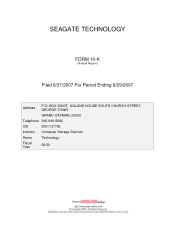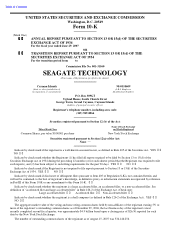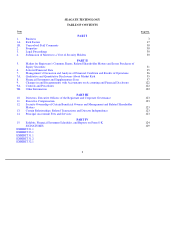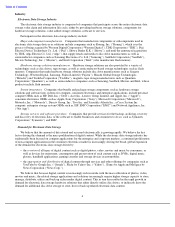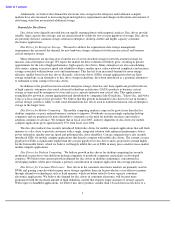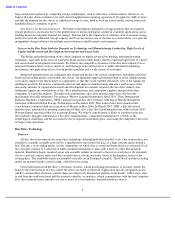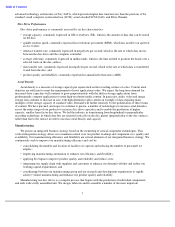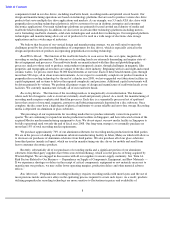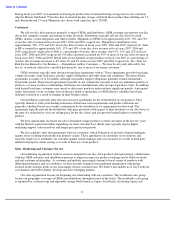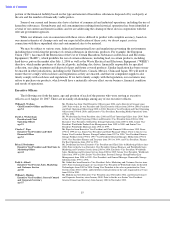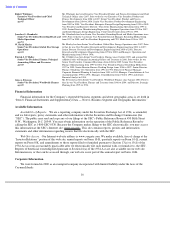Seagate 2006 Annual Report Download - page 9
Download and view the complete annual report
Please find page 9 of the 2006 Seagate annual report below. You can navigate through the pages in the report by either clicking on the pages listed below, or by using the keyword search tool below to find specific information within the annual report.
Table of Contents
large extent been replaced by competing storage technologies, such as solid state or flash memory. However, we
believe that disc drives continue to be well suited in applications requiring capacities of 20 gigabytes (GB) or more,
and that the demand for disc drives as additional storage to store, hold or back up related media content from such
handheld devices, continues to grow.
Disc Drives for Branded Solutions. We believe that industry demand for storage products like our branded
storage products is increasing due to the proliferation of media-rich digital content in consumer applications and is
fuelling increased consumer demand for storage. This has led to the expansion of solutions such as external storage
products to provide additional storage capacity and to secure data in case of disaster or system failure, or to provide
independent storage solutions for multiple users in home or small business environments.
Success in the Disc Drive Industry Depends on Technology and Manufacturing Leadership, High Levels of
Capital and Research and Development Investments and Large Scale
The design and manufacturing of disc drives depends on highly advanced technology and manufacturing
techniques, especially in the areas of read/write heads and recording media, thereby requiring high levels of capital
and research and development investments. We believe the competitive dynamics of the disc drive industry favor
integrated manufacturers such as ourselves, with the large scale and resources to make substantial technology
investments and apply them across a broad product portfolio and a wide variety of customers.
Integrated manufacturers are companies that design and produce the critical components, including read/write
heads and recording media, used in their disc drives. An integrated approach enables them to lower manufacturing
costs and to improve the functionality of components so that they work together efficiently. Due to the significant
challenges posed by the need to continually innovate and improve manufacturing efficiency and because of the
increasing amounts of capital and research and development investments required, the disc drive industry has
undergone significant consolidation as disc drive manufacturers and component suppliers merged with other
companies or exited the industry. Through such combinations, disc drive manufacturers have also become
increasingly vertically integrated. For instance, Maxtor acquired Quantum in April 2001. Then, International
Business Machines Corporation (“IBM”) merged its rigid disc drive business with that of Hitachi through the
formation of Hitachi Global Storage Technologies in December 2002. This trend of disc drive manufacturer
consolidation continued with our acquisition of Maxtor in May 2006. In March 2007, TDK, a disc drive head
manufacturer, announced its pending acquisition of Alps, also a disc drive head manufacturer, while in June 2007,
Western Digital announced that it is acquiring Komag. We believe consolidation is likely to continue in the disc
drive industry through combination of disc drive manufacturers, component manufacturers, or both, as the
technological challenges and the associated levels of required investment grow, increasing the competitive necessity
of larger-scale operations.
Disc Drive Technology
Overview
All disc drives incorporate the same basic technology although individual products vary. One or more discs are
attached to a spindle assembly powered by a spindle motor that rotates the discs at a high constant speed around a
hub. The discs, or recording media, are the components on which data is stored and from which it is retrieved. Each
disc typically consists of a substrate of finely machined aluminum or glass with a layer of a thin-film magnetic
material. Read/write heads, mounted on an arm assembly similar in concept to that of a record player, fly extremely
close to each disc surface and record data on and retrieve it from concentric tracks in the magnetic layers of the
rotating discs. The read/write heads are mounted vertically on an E-shaped assembly. The E-block and the recording
media are mounted inside a metal casing, called the base casing.
Upon instructions from the drive’s electronic circuitry, a head positioning mechanism, or actuator, guides the
heads to the selected track of a disc where the data is recorded or retrieved. Application specific integrated circuits
(ASICs) and ancillary electronic control chips are collectively mounted on printed circuit boards. ASICs move data
to and from the read/write head and the internal controller, or interface, which communicates with the host computer.
Disc drive manufacturers typically use one or more of several industry standard interfaces such as
6

